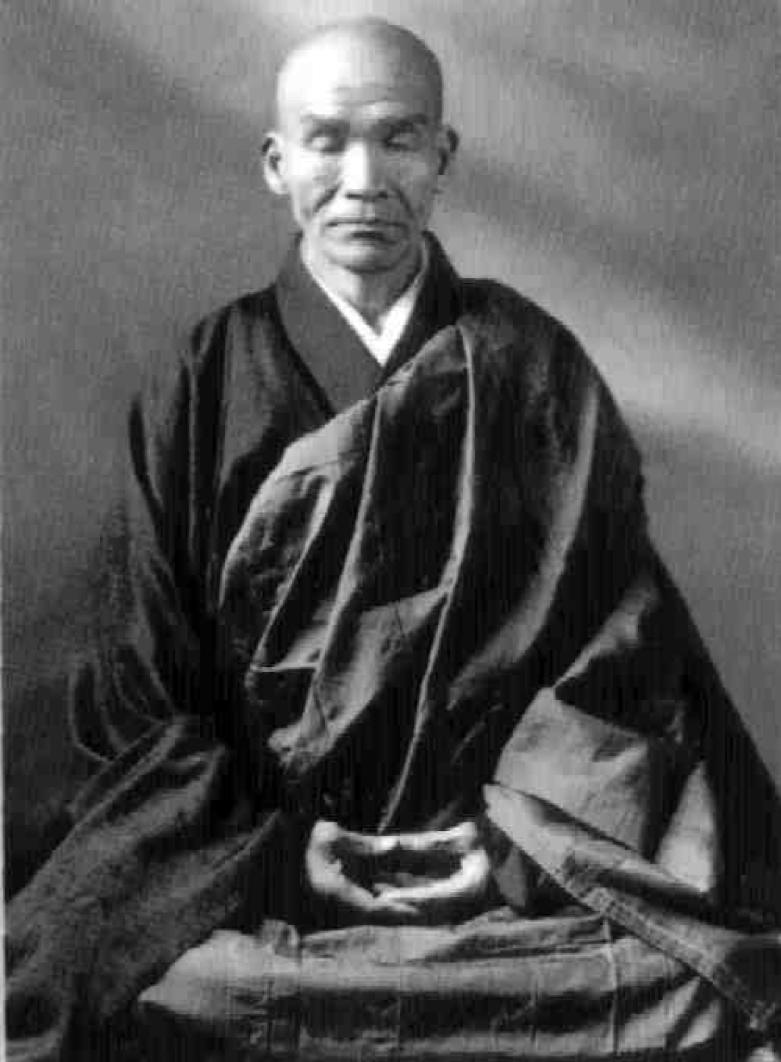
Meditation - Meditational Fundamentals
Master Kodo Sawaki (above) sits in profound Zazen meditation. He is postured up: structurally, he sits bolt upright, yet he maintains muscular relaxation. His breathing is low and deep, his hands are arranged in the cosmic mudra. The thumbs ‘lightly touch, as if holding a sheet of paper between them’ – if the thumbs separate, he has lost focus, if the thumbs mash together, he has lost focus.
The Zen Linebacker
Once you are convinced that you’d like to try this meditation thing, how does a beer-drinking, gun-loving, steak-eating, run-and-bang, rough-and-crude alpha get started? The first order of business is to approach beginner meditation as exercise.
Start by stripping the spirituality out of meditation. Rip out the visions, auras, rainbows, golden unicorns, fairy dust and gurus. Take out the fuzzy and indistinct and turn meditation into something alphas can wrap their brains around: a breathing exercise. We turn posture into technique and breathing into training.
In order to maintain the highly exacting meditational posture, in order to maintain the rhythmic power breathing, in order to maintain the delicate mudra, mindfulness need be attained and retained. Mindfulness is tricky. Most alphas mistake willpower for mindfulness. Willpower is fossil fuel whereas mindfulness is solar energy. Every act of will is mechanical and finite, every act of mindfulness is frictionless and infinite.
Willpower can be used to force the internal voice to grow silent - however this is not the quality of silence we seek. The conscious mind telling itself to be quiet is enforced silence and enforced silence is no silence at all. Real mindfulness occurs when we become so immersed, so absorbed, in what we are doing that the internal talker falls silent on its own.
The mediational Master effortlessly focuses on internal sensations: the low belly breathing, maintaining the erect yet relaxed posture, keeping the focal point of the eyes targeted, paying continual attention to the mudra, counting breaths. By using “soft” concentration, the Master takes in all sensations at once. The conscious mind, the thinking, reflecting-projecting internal voice fades away. Total absorption is mindfulness.
The master meditator becomes so acutely aware of the subtleties of “just sitting” that the Mind “falls away.” When the meditator becomes totally absorbed for an extended period, the effortless immersion is called Samadhi.
While enveloped in the Samadhi state, the meditator maintains a relaxed yet intense focus on the meditational object. This is not a sleepy, drowsy state, this is a state of hyper alertness, hyper-sensitivity.
The meditational goal is to maneuver oneself into the instantaneous present. When thought falls away, the “mind of no-mind” can be attained. Reality rips past us like a raging river and it can only be seen with a silent mind and total attention. Any kind of preoccupation precludes the perceiving of reality. You can’t multitask and attain Samahdi. The founder of Soto Zen, Dogen Zenji (1200-1241) termed proper zazen meditation as “Beyond thinking.” Most meditational schools use breath counting as an entry-level technique.
The meditator assumes the posture and counts concentrated breaths. Count from one to ten. If the meditator daydreams or engages a passing thought in an internal conversation, the count is lost. Go back to zero and begin again. Over time and with practice, the meditator develops the ability to repeatedly count from 1 to 10 uninterrupted. This is mindfulness manifested.
Over time and with practice, the zazen practitioner learns to relax more, sink deeper, pay better attention and become more attuned to the subtleties of the mudra. Once a session of sitting is done, the meditator feels relaxed, revitalized, energized and refreshed. During the meditational session, the overheated, overworked brain is taken offline and allowed to rest, relax and regenerate. The stressed-out, overused brain grows silent, and in that silence the brain can heal and repair itself.
Over time, practice deepens and ripens with repetition. For many meditators, there is never any need to evolve past breath counting. What is beyond breath counting? Zen Masters call meditation without breath counting, “throwing away the toys.” One classical meditational strategy is to initiate the session using breath counting. Once the flow and pattern of counting breaths has been established, drop the actual counting – yet maintain complete attention to breath and stay attuned to the mudra. What occupies our consciousness in the absence of counting breaths?
Nothing.
Electric blankness. “You”are there in the physical sense but psychologically, you are not. You sit and feel, you breath, you focus like a laser on the sight object. If a thought happens to arise, you note it – “Hey! a thought!” - but do not engage the thought. If noted and ignored, the thought melts away. Shunryi Suzuki once said, “Just because a thought appears doesn’t mean you have to invite it in for a cup of coffee.”
Thoughts are classified as “passing” thoughts or “clinging” thoughts. Real meditation is not about suppressing thought. Thoughts naturally arise from our subconscious. We have no control over that process. What we do have control over is the power of choice: we choose to not engage the thought. This way thoughts appear and fade away. Here are some technical check points for do-it-yourself meditation.

Zen Master Sawaki (above) is shown from the side: his spinal column is ramrod straight. His legs flow downward from the base of his spinal column to form a triangle. His abdomen expands outward and downward, powered by bellow-like diaphragm breathing.
- Posture up: like teaching someone to barbell back squat, when teaching meditational breathing the first order of business is to establish a technical archetype. Formal meditators sit on thick cushions filled with buckwheat kernel. Elevate the tailbone 3-6 inches.
- Sit up straight: don’t slump! Elongate the spin. Keep the head erect. If you slump, you have lost concentration. Straighten up and stay alert. When your Mind strays and you start daydreaming, the posture collapses. Recollect yourself. Realign yourself.
- Eye focus: some meditational sects have adherents close their eyes, other will focus the eyes on a lit candle, a mandala, an image of a god or guru. The eyes are not allowed to wander and are fixed with tremendous concentration on a single visual point - or closed.
- Leg placement: there are several acceptable ways in which to place the legs during formal meditation. The most common is the half-lotus, one ankle atop the opposite knee. Adepts use the full lotus. Sitting on your haunches or even in a chair is acceptable.
- Let the belly hang: with the tailbone elevated on a cushion, with the legs crossed or underneath, relax the gut, let it hang. Meditational power breathing commences in the Tanden. Every breath begins 2.2 inches below the navel and in the exact center of the body.
- Hand placement: the forearms rest on the thighs, each hand cradles the other, palms up, the pinkies touch the body under the tanden. The thumbs touch lightly. If the thumbs spread apart, you have lost concentration; if they crush together you have lost concentration.
- Relax and sink: in both seated meditation and moving meditation (tai chi) the meditator is taught “to relax and sink” With time and practice the meditator comes to learn that combining skeletal integrity with deep muscle relaxation causes the body to “drop away.”
- Breath low and full: every breath is begun by consciously pushing the diaphragm downward. Each breath should be measured: sometimes the mediator wants full and complete breaths, other time barely breathing is appropriate.
- Divide each breach into four parts: each breath starts with an inhalation. The inhalation ends with a minuscule pause, the “turnaround. The exhalation is followed by a second paused turnaround. Inhale, turnaround, exhale, turnaround. Now the cycle repeats.
- Counting breaths: posture up, establish 4-phase breathing, use the mudra as a bio-feedback device. Count breaths from 1 to 10. Say the number (internally) to yourself on the exhalation. If you lose count, go back to 1 and repeat.
Practice and patience: right now, having read this article, you now know all the meditational fundamentals needed to kick off your own practice. The audio environment is important. Quiet or Nature sounds are the preferred audio environment. If there are mechanical sounds or street noises, use headphones and listen to appropriate music. Silence is the preferred audio environment. Next comes Nature and natural sounds, then music. Control your audio environment.
Now control your visual environment. You have two choices, close your eyes or gaze at an object. Sit comfortably in some way that allows you to sit bolt upright – yet relaxed. The tailbone needs to be elevated. Align the legs. The diaphragm powers the breathing. Once you are properly positioned, launch the session, take the first inhalation. Be aware that most thoughts arise, not on inhalation or exhalation, but during the turnarounds.
Be mindful and vigilant at each turnaround. As you begin a gradual and measured exhalation, count “One….” Extend the word to match the length of the exhalation. Any passing thoughts at the turnaround? Begin the inhalation. Settle in, develop a mindful rhythm. Be on guard against drowsiness. True meditation is electrified and hyper-alert. Allowing the posture to collapse engenders the droopy and drowsy dream state that precedes sleep.
When you are able to do three rounds of 1-10 breathing without having to go back to zero, “Throw away the toys” and go “freestyle”. Meditational understanding really is this simple. Meditational mastery takes a lifetime. Start with short sessions: stay alert and sharp. Over time, maintain this quality of alertness and gradually lengthen meditational session length. Establish the quality, then and only then extend the duration. Have at it.
About the Author
As an athlete Marty Gallagher is a national and world champion in Olympic lifting and powerlifting. He was a world champion team coach in 1991 and coached Black's Gym to five national team titles. He's also coached some of the strongest men on the planet including Kirk Karwoski when he completed his world record 1,003 lb. squat. Today he teaches the US Secret Service and Tier 1 Spec Ops on how to maximize their strength in minimal time. As a writer since 1978 he’s written for Powerlifting USA, Milo, Flex Magazine, Muscle & Fitness, Prime Fitness, Washington Post, Dragon Door and now IRON COMPANY. He’s also the author of multiple books including Purposeful Primitive, Strong Medicine, Ed Coan’s book “Coan, The Man, the Myth, the Method" and numerous others. Read the Marty Gallagher biography here.


